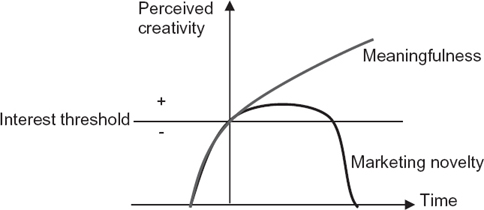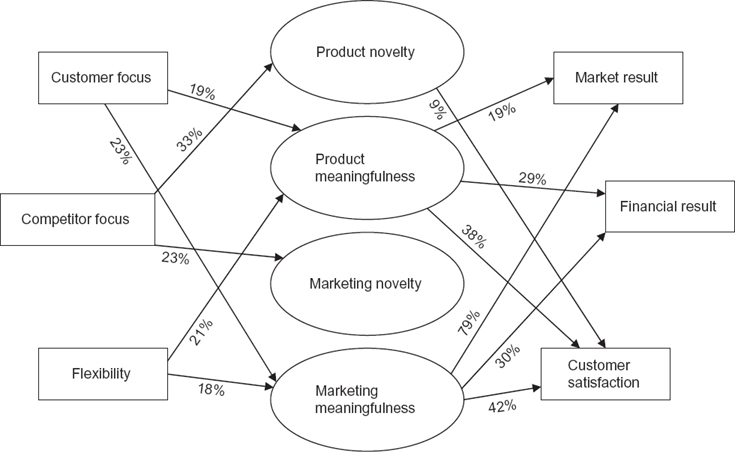7
The creative result
By far the most important aspect of creativity is the creative result. The result is creative if it fulfils two criteria. Firstly, it must be new and contribute something to the field that was not there before. Secondly, it must serve a purpose. Novelty has a very limited direct effect on a company's result. It is more important that the product is perceived to be meaningful.
By far the most important aspect of creativity is the creative result. In the introduction, we saw evidence that businesses that are perceived as creative are more successful. At the end of the day, success is what counts.
Most authors agree that the result is creative if it fulfils two criteria. Firstly, it must be new and contribute something to the field that was not there before. Secondly, it must serve a purpose. A blue ketchup bottle, for example, may not have been on the market before, but it is not particularly meaningful – why would anyone want a blue ketchup bottle? But if instead the ketchup bottle were in the shape of a cube, which is also new, it could then be meaningful.
A cubic ketchup bottle could be easier to store, both on the shelf and at home in the fridge or in a shopping bag. In contrast to the blue ketchup bottle, the cubic bottle is therefore creative.
The example of the ketchup bottle might seem trivial; changing the shape of a bottle is not especially revolutionary. But the fact is that most of the successful innovations – with the exceptions of TV, cars and telephones – are not particularly revolutionary (recall the study of improvement as opposed to paradigm-challenging innovations). For that matter, bottles are a good example of how an innovation that initially did not seem to be especially revolutionary (plastic recyclable bottles) changed the market in a very short time when they replaced glass bottles, which were heavier and less durable. Let us return for a moment to Figure 3.1, which showed how a creative result in the form of product creativity and marketing creativity leads to improved market results, financial results and customer satisfaction. Researchers found that both product creativity and marketing creativity could be divided into two parts: novelty and meaningfulness.
In the new model (Figure 7.1), we can see that neither product novelty nor marketing novelty have any real effect on the company in terms of its market position or the company's profit or loss. Product novelty has a certain effect on customer satisfaction, but does not affect the results.
One explanation is that only a small group of customers are satisfied by something new (the latest thing). Another explanation is that product novelty does not last, because eventually – or fairly quickly, as a rule – the product is no longer the latest thing and thereby loses its value. This gives us an opportunity to destroy the myth that one should always aim for the innovators, or lead users, when developing and marketing new products. The problem with these small customer groups is that although the novelty of the product and the concept is attractive, the novelty does not last, and nor does it appeal to the larger customer groups.
It is true that most success stories (the iPod, for example) have started among lead users and then spread to the broader masses. But the same is also true of the majority of failures. Attracting lead users demands great focus on novelty, which is not interesting to the vast majority of people. Furthermore, lead users are, on the whole, bad at passing the product on to other customer groups, because they are not interested in the product's meaningfulness and therefore cannot communicate it.
In fact, research has shown that the most important explanation for the frequent failure in the long-term of cutting-edge and paradigm-challenging innovations is the social implications of the product, and the fact that people have difficulty in understanding and appreciating its usefulness. Focus on lead users, which is easy to understand because they are a rewarding target group that quickly takes to new offers, is therefore an important explanation for the failure of many product launches in the long term.
Is novelty, then, not so important? On the strength of the numbers, one could easily form that impression because novelty has a very limited direct effect on the company's bottom line. But marketing novelty fills a very important indirect function. For a product to be perceived as meaningful, people must notice it and be interested in it. We have noted earlier that people either cannot or do not wish to investigate the qualities of every product, and that the brain prefers not to work and would rather use stored information.
In order to motivate the extra effort, it is necessary for the product to be noticeable by offering something new or unexpected. The correlation is illustrated in Figure 7.2. Novelty value is a prerequisite for crossing the threshold and for the product to be perceived as creative. The greater the novelty value, the lower the threshold and the longer the period of time during which the product can been perceived as creative. As novelty value gradually fades, the risk that competing companies may be seen as creative increases. As Figure 7.1 shows, it is indeed ‘Competitor focus’ that has the main effect on the novelty value of a product and its marketing.



